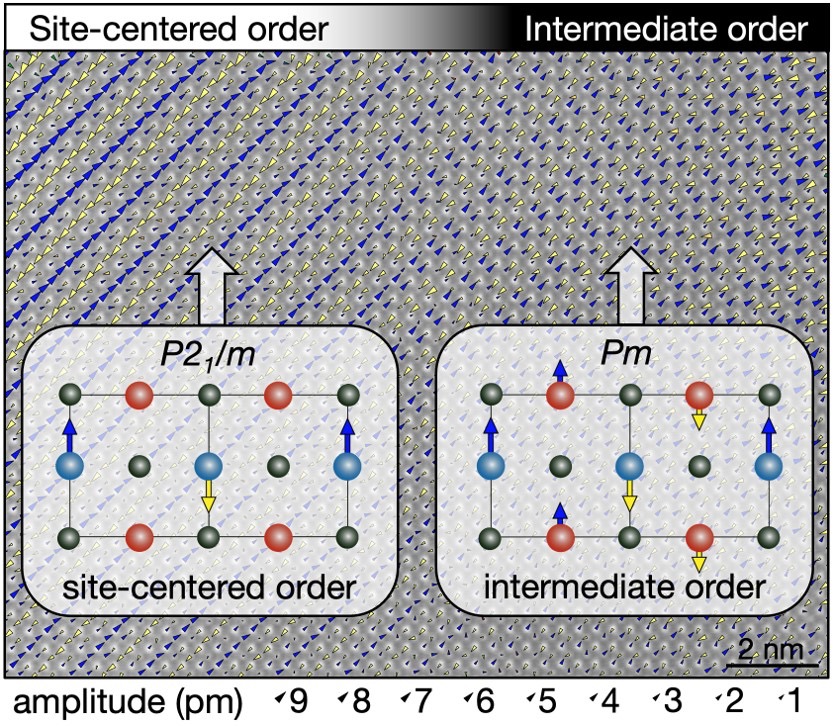Cryo-STEM Unveils Electronic Order at the Atomic Scale
https://www.paradim.org/
Lena F. Kourkoutis, Elisabeth A. Nowadnick, Harold Y. Hwang
In quantum materials, electrons can interact strongly with each other and with the atomic lattice, giving rise to novel electronic states with functionalities not achievable in conventional materials. At the atomic scale, the local crystal symmetries are governed by variations in the charge distribution and subtle atomic displacements, dramatically affecting the material’s properties.

Figure 1: Nanoscale coexistence of site order and non-centrosymmetric intermediate order in a manganite crystal, Nd0.5Sr0.5MnO3, when cooled into its charge-ordered phase. Large field-of-view cryo-STEM map of picometer-scale displacements of Mn and Nd/Sr atomic columns shows a transition from site-centered order (left side) to intermediate order (right side). Insets: The symmetry of the distorted structures in the site-centered and intermediate charge-ordered phase.
Here, members of PARADIM’s in-house research team demonstrate the capabilities of cryogenic scanning transmission electron microscopy (cryo-STEM). When pushed to sub-Angstrom resolution and picometer precision, cryo-STEM provides a unique path to answering fundamental questions about the microscopic arrangement within charge-ordered states. Using a half-doped manganite as a model system, they achieve a direct, atomic-scale visualization of the prototypical site-centered charge order, a model proposed over 60 years ago. They also discover an exotic intermediate charge-ordered state that breaks inversion symmetry and coexists at the nanoscale within the same material. Combining cryo-STEM to visualize lattice order with crystal symmetry analysis and density functional theory calculations, reveals a nonlinear coupling mechanism behind the formation of distinct ordered states providing a potential path to controlling electronic phases in these materials. More broadly, the results demonstrate that cryo-STEM is a powerful technique for understanding low temperature phenomena in quantum materials at the atomic scale.
What has been achieved:
The self-organization of strongly interacting electrons into superlattice structures underlies the properties of many quantum materials. How these electrons arrange within the superlattice dictates what symmetries are broken and what ground states are stabilized. Here we show that cryogenic scanning transmission electron microscopy (cryo-STEM) enables direct mapping of local symmetries and order at the intra-unit-cell level in the model charge ordered system Nd1/2Sr1/2MnO3. In addition to imaging the prototypical site-centered charge order, we discover the nanoscale coexistence of an exotic intermediate state which mixes site and bond order and breaks inversion symmetry. We further show that nonlinear coupling of distinct lattice modes controls the selection between competing ground states. The results demonstrate the importance of lattice coupling for understanding and manipulating the character of electronic self-organization and that cryo-STEM can reveal local order in strongly correlated systems at the atomic scale.
Importance of the Achievement:
Spatial heterogeneities that govern the mechanical, thermal, and electrical properties of crystalline materials such as domains, grain boundaries and defects are also critical for quantum phases many of which emerge at low temperatures. This work demonstrates cryo-STEM as a powerful tool to spatially map such heterogeneity in electronic order in quantum materials. It allows quantification of local symmetries within the material and at boundaries between district phases. For quantum science, cryo-STEM enables a paradigm shift in our ability to probe spatial heterogeneities of charge and lattice degrees of freedom in low temperature quantum phases and quantum phase transitions.
Unique Feature(s) of the MIP that Enabled this Achievement:
This work was only possible because of PARADIM’s unique cryogenic STEM setup, developed by PARADIM’s in house team, that allows for atomic-resolution and high-precision measurements of the atomic structure of quantum materials.